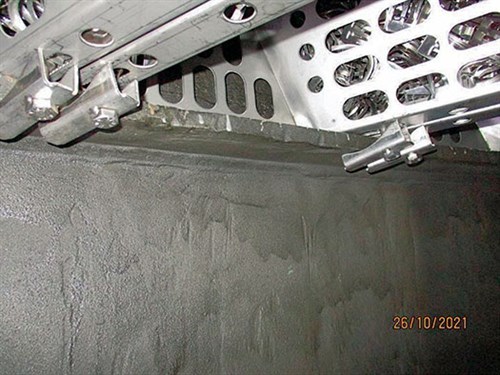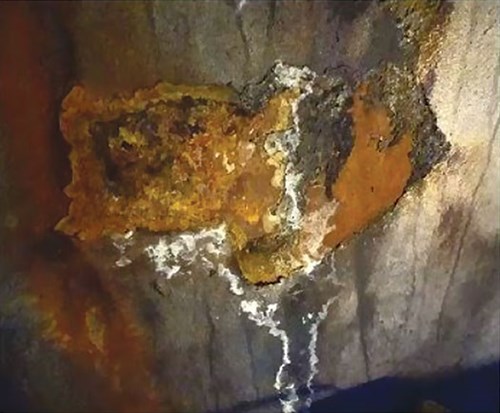Case study: The science behind amine process column corrosion and remedial solutions
This case study examines how and why corrosion takes place within amine vessels, the corrosion mitigation strategies available, and a comparison of high-velocity thermal spray (HVTS) with a low-velocity alternative.
In 2015, a gas plant in the Middle East identified internal corrosion in two of its amine process columns and contracted the author’s company to apply HVTS alloy cladding to protect the base metal. The HVTS cladding was applied, and in 2016, the plant went out to public tender for the completion of a similar work scope on six more columns. The plant decided to use a local thermal spray contractor on a cost basis, which involved using a conventional low-velocity thermal spray process technology.
Amine vessel corrosion mechanisms. To understand the solution to the problem, it is important to first understand the science behind the problem of corrosion—in this case, the amine vessel corrosion mechanisms. In the amine system, most of the corrosion is related to acid gas breakout and the subsequent attack on the metal surface, usually at elevated temperatures. Since corrosion is a chemical reaction, high temperatures always accelerate corrosion activity because reactions occur faster and more aggressively at higher temperatures.
Often, several factors contribute to failure by corrosion. Statistics show that almost 50% of corrosion incidents occur in the hottest part of the plant: the reboiler and the bottom of the amine regenerator. In amine plants, most corrosion is related to hydrogen sulfide (H2S) or carbon dioxide (CO2) breakout and the subsequent attack on the metal surfaces, usually in areas of elevated temperature or high pressure drop (leading to condensation).
More potential corrosion mechanisms exist in amine columns. In the lower section of a regenerator, for example, carbon steel surfaces not wetted by the amine solution may be attacked by water vapor and the formation of carbonic acid. Acid gas ratio, choice of amine (DEA, MEA, MDEA, DGA, AGR, etc.), contaminants, two-phase flow, flashing, high velocities, vessel design and insulation are all contributing factors. Pitting, crevice corrosion, flow-enhanced corrosion and general corrosion loss are frequent problems.
In this case, the plant in the Middle East conducted a planned inspection and noticed pitting in its amine process columns that would eventually lead to failure if left untreated and potentially cost the plant millions of dollars to replace the columns.
Several solutions are available to treat the issue of corrosion; while the damage cannot be reversed, if repaired using the correct technique and application, the lifespan and performance of the equipment can be significantly increased.
Corrosion mitigation strategies in amine treatment. Many amine towers have the top dome and upper area of the vessel clad with 316 stainless steel as part of the original design. Process control and changes to the feed typically mean that the amine column will experience corrosion in other areas of the vessel, often directly below the clad section. The nature and form of the corrosion mechanism often manifest themselves as a localized pitting attack with high corrosion rates. That can quickly remove the corrosion allowance and damage the integrity of the unit, requiring intervention and mechanical repair to rebuild the pressure boundary.
Aside from operational considerations, several mitigation or repair strategies have historically been employed when internal shell loss occurs. Some mechanical options include the installation of temporary clamps and plugs, vessel section replacement, and the application of an internal weld overlay. The time required for these, as well as the post-weld heat treatment (PWHT) required to remove heat affected zones (HAZs) and structural support considerations, often demand extended turnaround or shutdown schedules and associated production losses. Temperature and chemical compatibility limitations have prevented the effective use of organic coatings. Due to the nature of the sour feed, loss of containment poses major safety and environmental risks.
The gas plant in the Middle East chose to use an alloy cladding solution to fix the issue of corrosion in its amine process columns. This solution provides the same benefits as a high-nobility weld overlay corrosion barrier, with several additional advantages—including a rapid application speed—without requiring an HAZ or PWHT, or distortion of base materials. In the following section, the results of the application of HVTS on two of the columns vs. the low-velocity thermal spray applied by a local contractor on six of the columns in 2016 are discussed.
The inspections: High-velocity vs. low-velocity thermal sprays. The first inspection of the two columns protected by the author’s company’s HVTS took place in 2018. No signs of further corrosion were found, and the protective cladding was in excellent, as-applied condition.
An additional inspection by the plant’s senior corrosion engineer in November 2021 revealed a staggering contrast between the two columns sprayed with HVTS in 2015 (FIG. 1) and the other columns applied with the low-velocity thermal spray in 2016. The HVTS was still in excellent condition, with no signs of cracking or failure. However, the other columns sprayed with the low-velocity thermal spray (shown in FIG. 2) indicated extreme signs of breakdown of the applied cladding and corrosion of the substrate, with the wall thickness loss threatening to exceed its maximum corrosion allowance.
 |
| FIG. 1. The 2021 inspection of HVTS in 2015 (applied by the author’s company) shows the cladding in excellent condition. |
 |
| FIG. 2. The 2021 inspection of the six columns coated with a low-velocity thermal spray showed severe corrosion and risk of failure. |
If left, the continued corrosion could result in an unplanned shutdown, potentially costing millions of dollars in lost revenue. In the best-case scenario, the column would need to be stripped of the remaining cladding, undergo mechanical repairs (which is both costly and time consuming), and then be protected with a long-lasting HVTS.
The science behind HVTS, material modification and application technology. This scenario is a common occurrence at many oil and gas, refining and petrochemical sites. Although the initial cost of low-velocity thermal spray is often much lower, the long-term expense far outweighs the short-term savings. To understand why the low-velocity system failed, the science behind various types of materials and application methodology must be explored.
Standard welding alloys are unsuitable materials for thermal spray application in critical internal process equipment, as the cladding particles form oxides on their surface in flight, creating a fundamental weakness in the microstructure and permeability. The author’s company develops alloys designed and modified for high-performance thermal spray application.
The author’s company’s HVTS conveyance technologies atomize the bespoke wire feedstock in a supersonic gas stream, producing a cladding that consists of flat and tightly packed micro-sized particles. Conventionally available thermal spray application systems cannot produce equivalent particle sizes—they have a more open microstructure and do not impart sufficient energy to flatten the particles that are inherently highly stressed. These shortcomings lead to premature failure due to permeation from microstructural weaknesses and cracking of the coating.
Takeaway. The results seen at this gas plant confirm the performance difference between applying an HVTS vs. a conventional thermal spray, eliminating the corrosion process. Visually seeing the difference between the columns in this case study sprayed in 2015 and the columns sprayed with a low-velocity thermal spray is reassuring to owner-operators. The system and application process have been successful in preventing any further degradation or wastage and resulted in significant savings for the client. GP
 |
DENNIS SNIJDERS is the Senior Regional Director, Middle East and North Africa, for IGS. He has worked for more than 20 yr in the corrosion industry, 15 yr of which have been spent in the Middle East. In his present position, he is responsible for managing the Middle East and North Africa regions for the entire surface technology solution portfolio of IGS.




Comments